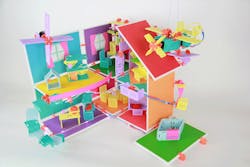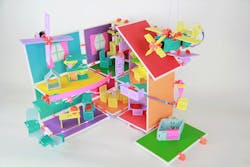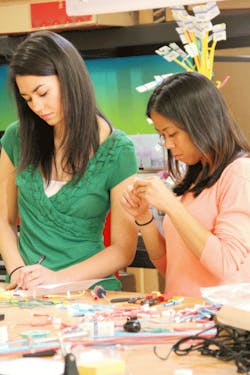Interview: Toy-Company Founder and Female Engineer on Girls in STEM
Ask any woman in a technical field to think back on what toys she liked best when she was a girl, and chances are at least one plaything had linkages, moving parts, or features with a technical slant. In fact, such toys can cultivate interest in engineering.
Now start-up company Maykah Inc., Mountain View, Calif., emphasizes technical functions to combine what a lot of traditional toymakers make for girls — story-based playthings that have a domesticating slant — with parts that let girls make their own mechanical and electrical toys for imagining their own narratives.
The idea is to engage girls’ natural inclination towards play that involves storytelling related to relationships, role playing, and communication (an inclination psychologists confirm in myriad studies) with technical activities. That way, girls can make things as a way to hone their spatial skills — the ability to mentally manipulate objects — which are fundamental to design and engineering work.
I recently chatted with Alice Brooks, M.S. mechanical engineering from Stanford and cofounder of Maykah Inc., about how she and her business partner Bettina Chen started their company to make the technical toys for girls. Here’s what she had to say.
Maykah’s flagship product is a parts set called Roominate, a room-themed toy. When the company was started, was this always going to take that form?
Brooks: When we started, our mission was to get more girls building and using circuits, and expose them to tools and toys they don’t usually get at home or in school. We didn’t even know what the toy was going to look like. We just knew we wanted to make some kind of building toy. So we observed girls playing with toys and some prototypes we made.
That was in 2011 and 2012, when you observed test groups of girls playing with your prototypes at local events and at the Children's Creativity Museum in San Francisco. Did you observe anything surprising about how girls play that prompted you to change the toy design?
Brooks: We found that they engaged most in engineering circuits and building when it was an essential part of play — and we had to find the right context for that.
To illustrate, in one scrapped prototype, we had girls make a car and then design an animal to go on top of the car. The little pet then followed them around. The problem there was, the girls had to connect all the linkages and circuits to get to the “fun” part after. So the actual building and wiring of circuits weren’t part of the toy’s “fun” functions.
After more testing and iterations, we settled on a dollhouse that lets girls design spiral staircases, lighting, elevators, Lazy Susans, and more. Once we gave them that context, the girls got so excited about the building and wiring that they actually exceeded the task and used the toy beyond its domestic-home setting. To date, girls have used the toy set to build Golden Gate Bridges, fridges, car washes, airplanes, and many other things.
You met Bettina Chen, your business partner, at Stanford. What made you team up to found Roominate?
I was a mechanical engineer from MIT and Chen was an electrical engineer from Caltech. We met as graduate students and were two of only a few women. We quickly became friends and discussed why we chose engineering for our careers, and why we stuck with it.
We realized that things we played with when we were younger had gotten us excited about building and tinkering and creating before we even knew what engineering was. For me, it was when I was eight: That year, I asked if Santa Claus could bring me a Barbie. Instead I got my own saw. So, I started making dolls, dollhouses, and animals out of wood and nails, and it was really fun — a creative, open-ended, hand-born process. Chen and I saw that as an uncommon experience for girls today.
So we started looking for ways to make girls handy at a young age. In fact, research shows that developing spatial skills is really important for opening doors later to STEM involvement. So, we decided we were going to make a toy … and we both love toys … so it was a natural decision there.
We started work on this about two and a half years ago — right as we were finishing up our master’s degrees.
What did you think you were going to do with your degree before you got into the toy business?
Brooks: I had a lot of different ideas, particularly when I was writing my thesis. When I was at MIT, I was really interested in product in design, but I was also really interested in energy technologies. I think some of those interests show in the Roominate toy — particularly the product design. In fact, I actually did some toy designs while I was at MIT. Some of those skills came in handy with Roominate.
You live in Northern California, known for being a technology hub. Do you think that girls in that area are more or less encouraged to pursue STEM careers, accounting for the overall greater prevalence of STEM majors?
Brooks: One key factor that influences whether girls pursue a STEM field is whether her parents are both in STEM jobs. In Northern California, that’s not an uncommon scenario — though certainly a different environment than where I grew up, in the Boston area.
Silicon Valley is also unique because there’s so much entrepreneurship. In fact, at some local schools here, they even teach entrepreneurship to fourth graders.
Our area also has a lot of Makerspaces on school premises, where kids get to use laser cutters and 3D … which is really, really cool. Our Roominate toy is in a lot of these Makerspaces.
What organizations there encourage girls to enter STEM type fields?
Brooks: There’s one organization called Tech Bridge, Oakland, Calif., and their mission is to expose girls in underprivileged areas to STEM projects. We’ve done workshops with them, and that’s what we find most exciting — to get involved on the ground. But a lot of effective programs are national, too — including the recent science fair at the White House, which focused on getting girls involved.
Have you met with other business bringing STEM-type toys to girls? Any plans to collaborate?
Brooks: We definitely run into other companies making STEM-focused toys, though we haven’t collaborated yet. I think just being part of a movement in which everybody’s working on this problem — getting more girls interested in building and circuits and STEM — is exciting. The more we do, the more options these girls have … and that’s going to expand their possibilities. After all, engineers design all the products around us, and without women, we miss out on a half the population’s ideas to solve problems — and a lot of potentially great solutions. It’s important that we bring more diversity to the teams designing the technologies we use.
In the spirit of STEM thinking, is there any hard data that shows that playing with Roominate improves girls' understanding of spatial relationships?
Brooks: We have feedback from parents that observe their children, plus our own observations of test groups on how the toy makes girls figure things out on their own about linkages and circuits — and quickly get more confident about attacking new problems. We also track quantitative data from Stanford researchers, Sheri Sheppard and Shannon Gilmartin. They conduct a lot of research into spatial skills development and how we should level the playing field between boys and girls in terms of spatial skills … and what that means down the line for students when they’re in school for engineering. In one paper, other researchers from Northwestern University detail how college kids in engineering have higher retention if they’ve had exposure to spatial-field development when they were younger. Still other research finds that exposing young children with lower measured spatial ability to skill-building toys gets them up to speed very, very quickly. They just need more practice, exposure, and opportunities at a young age.
How do you apply that data to your product design?
Brooks: For us, our product development relies on our understanding the customer and getting in front of our customers, too — so we can design things that most resonate with them. On a related note, I think that having engineers better represent the population as a whole will get us better designs to solve real engineering problems.
Do you have more toys planned?
Brooks: We have a lot of product ideas, mostly aimed at expanding the challenges for kids that play with our current toy lineup.
You grew up playing in her dad’s robotics lab. When you asked for a Barbie, he gave you a mini saw so you could make your own. Are you glad that you didn’t get that Barbie doll? Do you think your parents had an agenda?
Brooks: The mini saw was fantastic fun, and I am glad. Actually, it was my dad that didn’t want me to have Barbies, though my mom let me. In the end, they did get me a couple — plus a couple more Barbies found their way into the house through birthday parties. I still like Barbies — I just think it’s important to offer balance to girls, and not close off opportunities for them when they’re younger. If girls like Barbies, they can play with Barbies — but we can also make it normal for them to get to take things apart at home and build new things.
And clearly, we can’t tell all parents to go out and buy saws for their daughters, because even though I figured out not to cut myself, saws just aren’t the best toys for everyone. So at Maykah, we aim to let girls explore what they like doing, but challenge them.
More specifically, with the Roominate, even putting the batteries into the circuit’s power pack is for the girl to do. Some six-year-old girls have never even put batteries in something before. So, the Roominate comes with instructions to show them how to use a screwdriver, open up the battery pack, and put in batteries. Likewise, it tells them how to build a windmill and wire it ... and so much more. Letting a six-year-old do these things independently is really empowering. But at the same time, that windmill might go into their dollhouse. There are lot of different skills girls can develop doing all these different sorts of play. I think it's important to expose kids to all different kinds of things.
How do we get more girls interested in STEM fields?
Brooks: We can get young girls interested in sciences and engineering and technology just by showing them how creativity is an essential part of all three. I think engineering is particularly fun because it requires creativity to find solutions to challenges … and engineers must use available tools to figure out how to solve challenges.
We’re trying to show kids that with Roominate — and that being creative is part of the engineering process. If more kids knew that, more would be interested in mechanical or electrical engineering. Part of the problem is that sometimes their first exposure to STEM fields is the boring side of it in school — with things that don’t apply to what they’ll be doing in the future.
I think engineering offer young women a career track unbounded by unhelpful societal messages. STEM jobs also offer innumerable opportunities for what psychologist Mihaly Czikszentmihalyi calls flow, a blissful state of concentration and complete absorption with an activity.
Brooks: Yes, and it’s just so empowering too. Once you’ve been able to solve one problem, then you can take on anything — right? You know that you have the skills and the tools, and even if you don’t know the solutions right away, you’re going to be able to figure it out. That’s what I love about engineering.
About the Author
Elisabeth Eitel
Elisabeth Eitel was a Senior Editor at Machine Design magazine until 2014. She has a B.S. in Mechanical Engineering from Fenn College at Cleveland State University.


